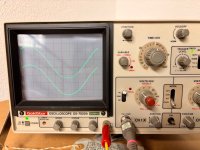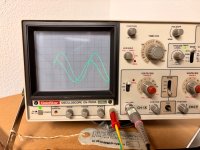The phase delay is a property of the RIAA filter poles and zeroes, its a minimum phase filter. If the RIAA response curve is accurately followed the phase delay will be correct.
Your coupling capacitors may be adding phase shift that need not be there.
Set their poles to 5Hz or less.
Set their poles to 5Hz or less.
Well, the theoretical values/math are correct. So even if small practical adjustments is needed (after measuring), the baics are right. My question was more of a general one. Is there any charts showing what phase delays to be expected, caused by the riaa poles and zeroes?
The two oupling cap-poles are in the 1,5Hz range.
So far I haven’t measure the frequency responce. Just connected my signal gen (at a mV level). To see if the amp was alive or not. This measure shows the phase delay between input and output at 1KHz.
The two oupling cap-poles are in the 1,5Hz range.
So far I haven’t measure the frequency responce. Just connected my signal gen (at a mV level). To see if the amp was alive or not. This measure shows the phase delay between input and output at 1KHz.
It is useless to look at a phase deviation with a single frequency.
Use Anti RIAA between signal generator and input and check the output.
Use Anti RIAA between signal generator and input and check the output.
Pretty easy to knock up in LTSpice: dotted line is phase, scale on right hand side.Is there any charts showing what phase delays to be expected, caused by the riaa poles and zeroes?
The response plotted was:
.Here is the actual theoretical phase response for the zero and two poles (and not for an entire RIAA phono preamp).
Note that at low frequencies the phase approaches 0 degrees, and at high frequencies the phase approaches -90 degrees,
as expected.
https://pspatialaudio.com/phono_preamps.htm
Note that at low frequencies the phase approaches 0 degrees, and at high frequencies the phase approaches -90 degrees,
as expected.
https://pspatialaudio.com/phono_preamps.htm
I think this is in error. After cutting the record with "inverted" RIAA
and then again playback with RIAA correction amplitude and phase
should be preserved.
It is useless to look at the RIAA preamp alone.
and then again playback with RIAA correction amplitude and phase
should be preserved.
It is useless to look at the RIAA preamp alone.
Well that’s the ultimate objective. If your EQ has the right number of poles and zeros and the frequency is up 19.911dB at 20Hz and down -19.911dB at 20kHz, both referred to 0dB st 1kHz, both the frequency response and phase response must be correct. So that’s all you need to actually measure.So far I haven’t measure the frequency responce.
Your coupling capacitors may be adding phase shift that need not be there.
I'm curious to know, Ray, why any coupling caps on the output of the phono stage will add a phase shift to the phase shift inherent in the RIAA network?
Set their poles to 5Hz or less.
Do you mean choose their value so that their -3dB roll-off point (which is dependent on the Zin of preamp being fed by the phono stage) is a max of 5Hz?
Any capacitor adds a 90 degree phase shift.why any coupling caps on the output of the phono stage will add a phase shift
Yes.Do you mean choose their value so that …
Thanks. 👍
Sure ... but this is a constant 90 deg added to whatever phase curve the phono stage produces - see here:
... so why will this be a problem?
Don't forget that the input coupling cap in the preamp or amp fed by the phono stage ... will add another 90 deg! 😵
And as for the second part of your answer:
Given that the effect of the roll-off is felt up to 10x the roll-off frequ - surely a cap value delivering a roll-off frequ of 2Hz would be more desirable ... given 2x 10 (ie. 20Hz) is what we regard as the "theoretical" lower end of the desired 20-20kHz frequ response?
Any capacitor adds a 90 degree phase shift.
Sure ... but this is a constant 90 deg added to whatever phase curve the phono stage produces - see here:
... so why will this be a problem?
Don't forget that the input coupling cap in the preamp or amp fed by the phono stage ... will add another 90 deg! 😵
And as for the second part of your answer:
Yes.
Given that the effect of the roll-off is felt up to 10x the roll-off frequ - surely a cap value delivering a roll-off frequ of 2Hz would be more desirable ... given 2x 10 (ie. 20Hz) is what we regard as the "theoretical" lower end of the desired 20-20kHz frequ response?
So what’s your question?Sure ... but this is a constant 90 deg added to whatever phase curve the phono stage produces - see here:
In itself, yes. In a realistic R-C circuit, the phase shift is determined by the resistance vs. capacitive reactance ratio.Any capacitor adds a 90 degree phase shift.
You asked, and I quote, ‘why any output coupling caps … will add a phase shift”, and I have answered that.
You asked, and I quote, ‘why any output coupling caps … will add a phase shift”, and I have answered that.
Yes, you did - thank you. 👍
As to this:
So what’s your question?
It's not so much a question as a bewilderment! 🙂
The OP asked:
What signal phase delay (input/output) is considered normal in a 2 stage, passive riaa- tube phono amplifier?
Good question - answered by Mark in Post #9. Everything made sense to me.
But then Ray threw in a curve-ball:
Your coupling capacitors may be adding phase shift that need not be there.
Set their poles to 5Hz or less.
So, given - as you said - any capacitor adds a 90deg phase shift ... I couldn't see why this result of using a coupling cap was relevant to a discussion of the phase change within a passive RIAA network (which tube phono stages typically use).
I guess Ray's comment was basically ... if you use a coupling cap - make sure its value results in a roll-off point of 5Hz or less?
This will help. Bear in mind that there will be at least two of these HP filters in a tube RIAA phono stage.
The RIAA response is that of the entire phono circuit, not just the passive RIAA components.
Each coupling capacitor adds up to 90 degrees of additional phase shift (which will vary with frequency) near or below the pole.
The phase shift at the pole frequency is 45 degrees, and the HPF adds about 5 degrees even at ten times the pole frequency.
https://www.electronics-tutorials.ws/filter/filter_3.html
The RIAA response is that of the entire phono circuit, not just the passive RIAA components.
Each coupling capacitor adds up to 90 degrees of additional phase shift (which will vary with frequency) near or below the pole.
The phase shift at the pole frequency is 45 degrees, and the HPF adds about 5 degrees even at ten times the pole frequency.
https://www.electronics-tutorials.ws/filter/filter_3.html
- Home
- Source & Line
- Analogue Source
- Phase delay in phonostage

